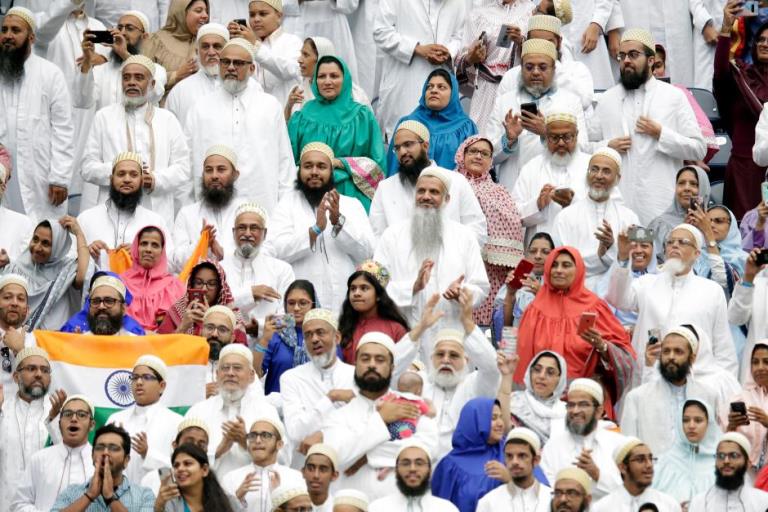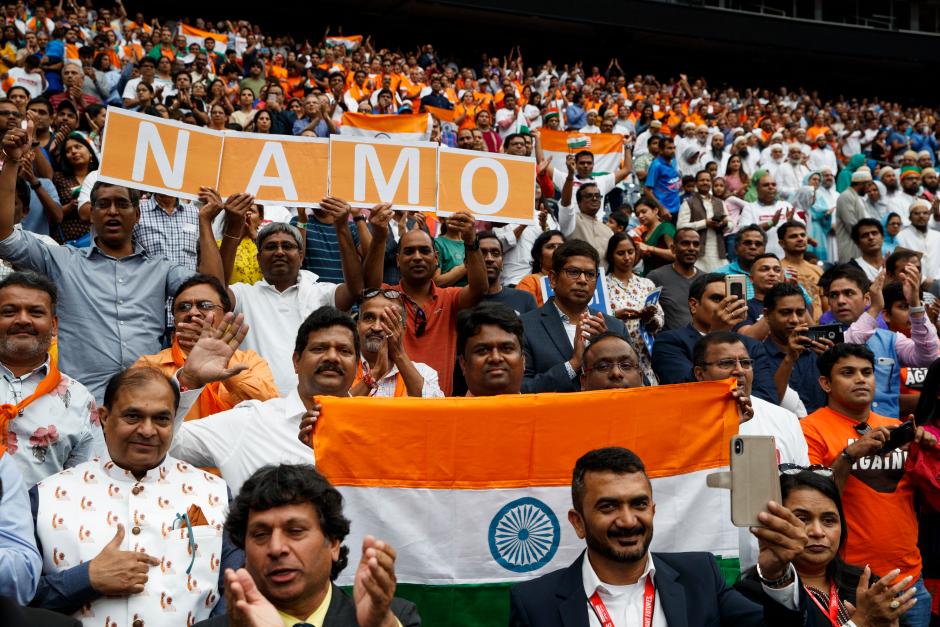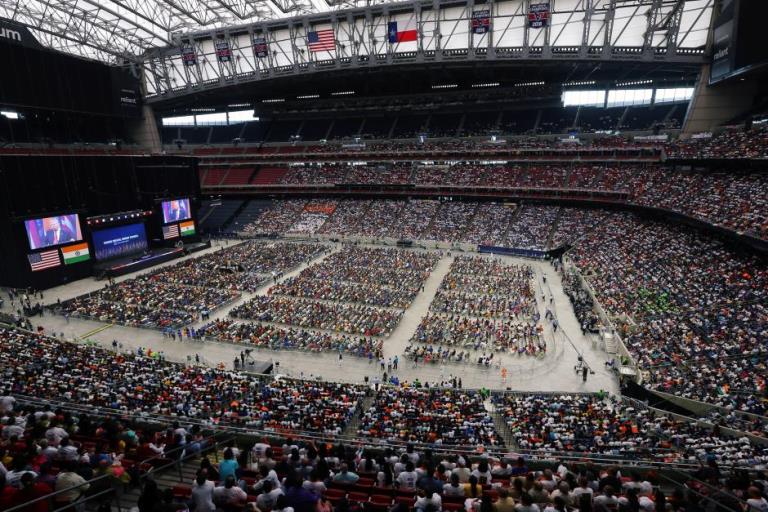Houston, September 23 (Hindustan Times): Indian Prime Minister Narendra Modi gives speeches. He gives good speeches. He gives speeches that charm audiences, energise them, motivate them, and persuade them. And he gives speeches that turn the tide of elections. Indeed, it is his speeches which have contributed — enormously — to the Bharatiya Janata Party’s incredible electoral success in India.
But even by his standards, Narendra Modi outperformed himself in Houston on Sunday. With one speech, which lasted just a little less than 50 minutes, Modi leveraged all of India’s strengths — its demography, diaspora, diversity, democracy, economy, the process of modernisation underway in Indian society, and its responsible track record as an actor in the international system.
Modi also spoke to different audiences both inside the NRG stadium and outside — President Donald Trump; Democrats; the Indian-American community; citizens back home glued to the speech; Pakistan; and the rest of the world.
The Houston event, in itself, was unique. The rise of the Indian-American community, and the ability of the Indian State in using the strength of this community, is not new. Their lobbying powers played a role in helping Delhi overcome opposition in Washington to the nuclear deal a decade ago. Diaspora events too are not new for Modi — his first address in Madison Square back in 2014 was a roaring hit, and set a template for many such events in other countries.

But why Houston stood out was because of timing. It was happening at a time when India has made an extraordinarily significant decision on Jammu and Kashmir and needed to win US confidence and neutralise any support for Pakistan’s efforts to internationalise the issue; it was happening at a time when Delhi-Washington ties have gone through a rough patch on trade; it was happening at a time when India has got negative press in the western media; and it was also happening at a time when globally, there is some concern about India’s economic trajectory.
But more than anything else, Houston stood out because Trump was to attend the 50,000 strong rally along with Modi, making it the first event of its kind.
If there were apprehensions about the protocol, sequence, context, and eventually the message that would emanate from the event, all of them were put to rest on Sunday. And it was largely because of the PM’s act.
Two strands, of selling the India story and sending a message to different groups, intersected in every comment Modi made.
The first target, make no mistake, was Donald Trump. India’s diplomatic need is clear. Both Modi, and his external affairs Minister S Jaishankar, see relations with US as crucial to helping India meet its own economic and strategic aspirations. This does not mean accepting every US demand, but it does mean having constructive and warm ties and arresting any drift that may crop up in the relationship.
This need did become more acute in recent months because Pakistan was playing hard, because of its role in the Afghanistan negotiations, to get US support on Kashmir. The change in the constitutional status of Kashmir and the subsequent clampdown of civil liberties in the Valley — now partially relaxed — made Islamabad think it could gain support in the West in particular. Delhi needed to both bring back ties with Washington to an even keel, and to neutralise any support it could potentially offer to Islamabad.
Washington today means Trump. Moral judgments about his governance, policies, and conduct do not matter in realpolitik. What matters is understanding the man, how he functions, what drives him, and how he can be “managed”.

The recognition that Trump has a high degree of personal vanity, but also that he has a political calculus driven by the need to win the next elections, drove Modi’s messaging. In his introductory remarks substantially, and less so, in his main speech, the Indian PM praised Trump’s leadership; his economic record; his commitment to US; and his negotiating skills – do note these are all traits Trump prides himself on. By introducing Trump to his most fervent supporters, who will have a vote in next year’s presidential election, and walking around the stadium with him, Modi was also offering to Trump a sense that the Indian PM can aid him in his own domestic battles, without saying so explicitly in any form and leaving a degree of ambiguity.
Modi’s comments have triggered a debate on whether it is indeed wise for an Indian leader to be seen as somewhat partisan in an election year in US. But that is a different debate — and there is enough room for India to say it was engaging with President Trump and not Candidate Trump. Modi’s objective was pleasing Trump, and he did so.
The second target was Pakistan. Modi deployed an elaborate, but extremely, shrewd rhetorical device to do. He justified, explicitly, the effective abrogation of Article 370 and termed it as instrument which had both impeded Jammu and Kashmir’s development and aided terrorism — in front of Donald Trump.
And then he mentioned how both 9/11 and 26/11 had roots in the same place; declared it was time for a “decisive battle” against terrorism, hailed Trump as a global leader committed to battling terrorism, and then got the crowd to give Trump a standing ovation on this count.

Coming soon after Trump’s own comments on how he is India’s best friend and the need to battle “radical Islamic terrorism”, the message that went out to Pakistan that its celebrations over Trump’s offer to mediate, or its hopes that US would crack the whip on India on Kashmir, were misplaced and premature. It was India and US which were actually together, with counter terrorism bringing them together.
Modi’s third audience was the broader US establishment, Democrats, and the liberal intellectual ecosystem. India recognises that US is deeply polarised, and that a substantial element of the country broadly subscribes to a liberal worldview. It also recognises that even within the Republican camp, voices on human rights may be muted but is present. And it is aware that the western press has focused on what it sees as a gradual whittling down of India’s democratic institutional framework.
It was to this audience that the PM leveraged India’s soft power. By speaking of India’s diversity – in language, religion, region, traditions — as its strength; reiterating unity in diversity as a central pillar of India; elaborating on both the long democratic experience of India as well as its more recent elections which saw a high turnout; Modi was seeking to allay apprehensions that India was somehow turning authoritarian or homogeneous, and, instead, building on the common thread of democracy and multiculturalism that binds the two countries.
The PM also elaborated on his government’s commitment to the poor and welfare schemes — this too was an effort to show India as a country on the path of progress, committed to equality and inclusion.
The fourth audience was US business. Modi spoke of India as a modernising country — a country which was leveraging technology, where cheap data was available to hundreds of millions of people; where the government was easing conditions for doing business, cutting red tape, slashing corporate taxes; and which had robust growth, increased investments, and was ready to embrace the world.
At a time when many global investors and firms have begun developing doubts about the government’s reform agenda, this was a message of reassurance to them.
The fifth audience was the Indian-American community, present in thousands in the stadium, and watching the event closely elsewhere in the US. By recognising their power, their presence, their contribution, Modi was instilling a sense of pride in the community. This has been an important source of support for him personally and politically, but also for India. It can be a major potential source of economic contribution, to some extent like the Chinese diaspora has been.
Many Indian-Americans saw Houston as a moment when they have truly arrived as a powerful diaspora group in US, with the president of their adopted country paying them a tribute. Modi built on it to energise them.
And finally, like any smart politician, Modi was addressing his own domestic audience back home. The rally, telecast live on all Indian news television channels, and live-streamed across platforms, was widely watched. The PM was fully aware that the act of being with Trump as an equal on the stage; the narration of his government’s achievements; the comments on Kashmir and Pakistan; the perception that India was finally getting its due on the world stage would work very well with voters back home. He pressed the right buttons to make them feel that India had truly arrived.
Critics will see Houston as mere symbolism. With Trump, they will suggest, rightfully, one cannot expect consistency — for all it may take is a tweet for the US president to make a critical remark on India. There is also legitimate apprehension on whether these statements on both sides will translate into more substance in the relationship.
But there is little doubt that Modi has scored a diplomatic triumph. He has redefined the optics of India’s relations with the United States. And he has achieved a key goal — New Delhi has gained crucial global currency at a critical time back home. The man does, indeed, give good speeches.



























































